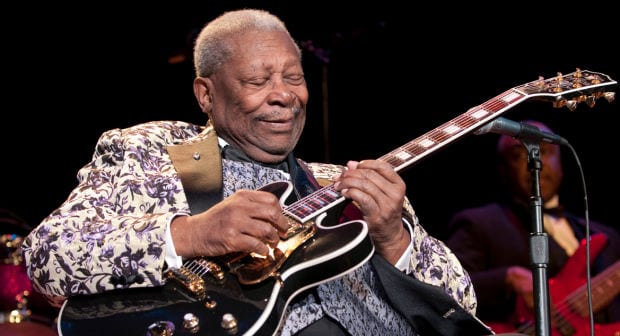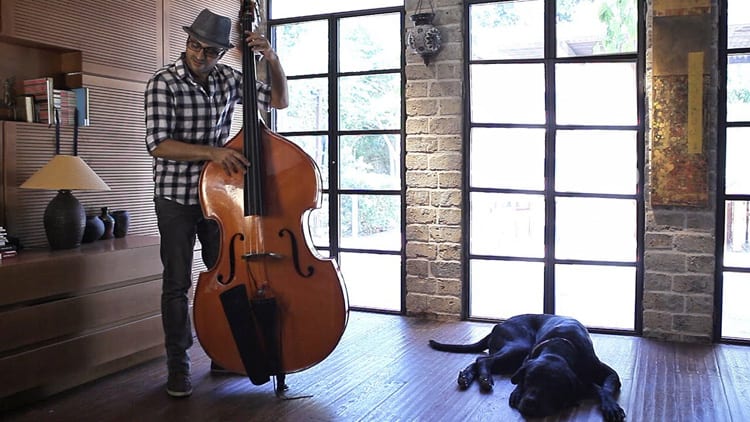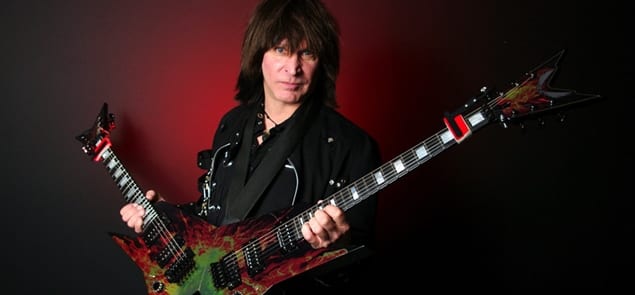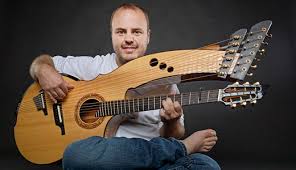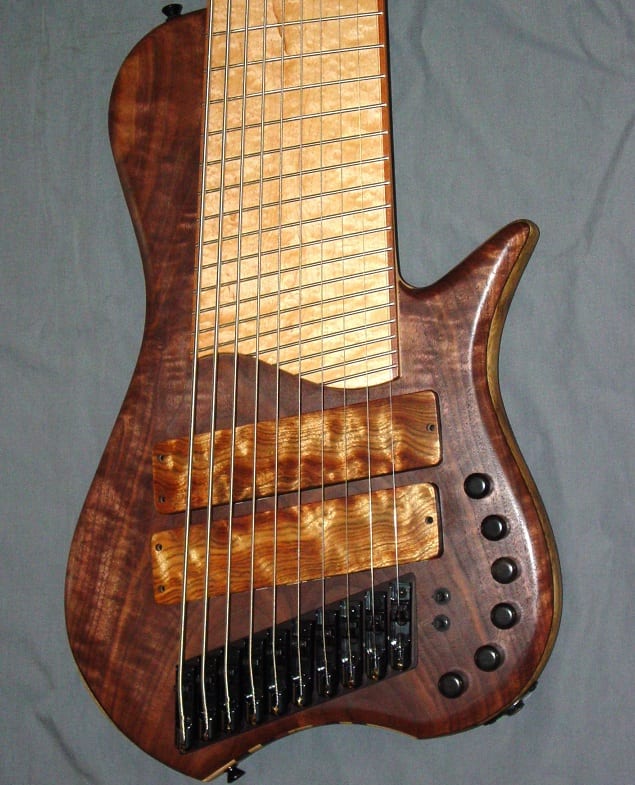Are you curious about what types of guitar there are? Here’s an overview of the 9 types of guitar (including when & why each type might be used).
There are 3 main types of guitar: acoustic, electric and bass. But there are some important variations within those groups that some people classify as different types of guitar entirely.
Let’s take a closer look….
Types Of Guitar #1 – Acoustic Guitars
This is the type of guitar most people are familiar with.
Acoustic guitars have hollow bodies which amplify the sound of the strings acoustically. They are usually made of wood, have six strings and look something like this:
Acoustic body shapes & sizes
There are a number of different body shapes of acoustic guitars. (There are many different sizes too.)
Some acoustics are symmetrical (like the one in the picture above) and others have a ‘cut-away‘, which means that a bit of the body of the guitar has been cut away to allow us easy access to the higher frets.
‘Dreadnoughts‘ and ‘Jumbos‘ have larger bodies which give off a big booming sound, whereas ‘Parlour’ and ‘Auditorium’ guitars have a quieter and more articulate tone.
For every type, there’s a range of sizes from ‘half size‘ to ‘three quarter size‘ to ‘full size‘. depending on the size of the guitarist’s body.
(A petite adult won’t be well suited to playing a full size Jumbo acoustic, so if you’re learning guitar, choose your guitar body shape carefully!)
You can learn a LOT more about how to choose a beginner guitar in this article (this also includes a more detailed overview of the different body types and sizes): What’s The Best Beginner Guitar?
Over 100,000 guitar-learners get our world-class guitar tips & tutorials sent straight to their inbox:
Click here to join them
Get our best guitar tips & videos
Acoustic string types
Some acoustics have steel strings which are ideal for folk, rock, blues & country.
Others have nylon strings which are better for classical and flamenco guitar.
6-String vs 12-string
While most acoustic guitars have six strings, there are some that have 12 strings.
Twelve string guitars are tuned the same as six string guitars, except each string is doubled, producing a lush harp-like sound.
While most acoustic guitars are made of wood, some, such as the famous National Guitar are made of metal!
The vast majority of the time acoustic guitars are tuned to the same notes and played in the same way, but the various types of guitar can produce very different tones.
Should you buy an acoustic guitar?
Acoustic guitars are ideal for beginner guitarists and singer-songwriters who want something to strum and/or fingerpick their songs on.
They’re not so ideal for players looking to bust out big, screaming, distortion heavy solos. For that, see electric guitars.
If you are looking to get into an acoustic guitar however, we highly recommend the Yamaha FG800. This dreadnought-style acoustic is as perfect for beginners as it is for professionals, and it plays as good as it looks.
Check it out at the links below!
Types Of Guitar #2 – Electro-acoustic Guitars
Electro-acoustic guitars are acoustic guitars that have a ‘pick-up’ (basically, a microphone) built into them so they can be plugged into an amplifier or a PA system.
This is a way of ‘connecting’ an acoustic guitar up to an amp to make it louder.
Should I buy an electro-acoustic?
Electros are ideal if you want to play live shows. With an electro you don’t need to faff around putting mics in front of your guitar.
Our favourite electro-acoustic guitar is the Ovation Applause AB28-5S. This super-slim guitar plays incredibly well, and sounds just as good with an amp as it does without.
Check it out for yourself!
Types Of Guitar #3 – Semi-acoustic Guitars
Semi-acoustic guitars (sometimes also called ‘hollow bodied electric guitars’) occupy something of a middle-ground between acoustic guitars and electric guitars.
They’re thin and compact like electric guitars, but have hollow bodies like acoustic guitars.
Because they’re thin and compact, they won’t produce quite as loud a sound when unplugged as an acoustic will, hence the term: semi-acoustic.
Some notable models of semi-acoustic are the Gibson ES-335 and the Fender Telecaster Thinline (basically a semi-acoustic telecaster).
Should I buy a semi-acoustic guitar?
Semi-acoustic guitars are ideal for players who want versatility. Something they can get an acoustic-esque tone with, but also play through a cranked up amplifier should they wish.
They’re not so ideal for people who want one or the other. (i.e., a fully acoustic sound or a fully electric sound.)
If you’re looking for a semi-acoustic guitar, we recommend the Epiphone ES-339. This is a classy instrument that can tackle many different genres with ease from jazz to country, rock and beyond.
Learn 12 EASY beginner chords with our popular guide


Where should we send it?
✅ Stop struggling. Start making music.
✅ Learn beginner-friendly versions of every chord.
This is our most popular guide and it will improve your chord ability quickly! 😎
Get your own personalised guitar-learning plan 🎸
Get a custom guitar-learning plan here: Click here for GuitarMetrics™
World-Class Guitar Courses 🌎
Learn from the world's best guitar educators: Click here for our guitar courses
Types Of Guitar #4 – Electric Guitars
Unlike the previous guitars, these guitars have solid bodies and as such, produce very little in the way of sound unless they’re plugged into an amplifier.
If you want to play electric guitar you will need an amp.
Electric guitars come in a variety of shapes and sizes. Some of the most iconic are: the Gibson Les Paul, the Fender Stratocaster and the Fender Telecaster.
Like the acoustic guitar, electric guitars are usually made of wood and usually have six strings, though there are twelve string versions available.
Should I buy an electric guitar?
Electric guitars are ideal for players who seek a powerful, sustaining sound or who want a much greater choice of sounds.
With an electric guitar the world of effect pedals is open to you and the sounds you can create are almost limitless.
Distortion, wah-wah, chorus, delay… There are thousands of ways you can use effects with an electric guitar.
Electrics are not as good for more traditional types of music such as folk. Many folk venues don’t use any electronic amplification whatsoever. (Not even a PA!)
If you’re ready to rock however, we highly recommend trying out a Squier Affinity Telecaster. These play unbelievably smooth (especially for the price!) and are a great foray into electric guitar playing for beginners.
It can get pretty confusing as to what string gauge you should pair with your guitars, so we created a lesson to help demystify the process. Click here to learn about guitar string gauges.
Types Of Guitar #5 – Bass Guitars
Once upon a time, being the bass player in a band meant lugging a huge double-bass as seen in orchestras and jazz bands to and from practice.
Thankfully, the good folks at Fender eventually came out with a guitar version of the bass that, among other things was a lot more portable than its predecessor.
Unlike regular guitars, bass guitars usually only have four strings, and they’re big, thick strings that produce a big, thick sound.
Bass sounds deep and low. Earth-shaking!
The most recognisable bass guitar is probably the Fender Precision, but there’s also the Hofner Violin bass as favoured by Sir Paul McCartney and the Rickenbacker 4001 as played by Bruce Foxton from The Jam.
Bass guitars are usually solid-bodied and electric, but there are acoustic and semi-acoustic basses available.
Some basses also have five or even six strings to allow a wider range.
Should I buy a bass guitar?
Bass is one of the ideal types of guitar for people who like the idea of working with the drummer to form the rhythm section and hold down the powerful low-end groove in a band.
Bass guitars are not so ideal for people who want to play big screaming solos or for people who fancy themselves as solo artists. Bass is a low-end, accompaniment instrument.
Want free guitar tips and video lessons delivered to your inbox?
Join over 100,000 guitar learners and subscribe to our guitar-tips-by-email service. (It's free.)
We'll send you a series of lessons that will move you to the next level of your guitar journey.
Learn how everything fits together quickly, easily and effectively. We share ninja tips (for instant fun!) but also timeless fundamentals that will deepen your understanding.


Get our best guitar tips & videos
Our Guitar Courses
To become a better guitarist click here to see our guitar courses
Get your personalised guitar-learning plan 🎸
Want us to make a guitar-learning plan that is customised to you? Click here for GuitarMetrics™
Types Of Guitars #6 – Cousins Of The Guitar
Fun fact: The guitar is a descendant of the lute.
There’s a number of other instruments that have sprung from the lute family as well. Think of these as ‘distant cousins’ of the guitar. These aren’t really types of guitar, but similar stringed instruments.
The Mandolin
Mandolins are a bit like strummed violins, in that they are tuned the same way, albeit with double the number of stings, but they are strummed like guitars rather than played with a bow.
They have a very bright, trebly sound and are popular in styles of music like folk.
The Banjo
Banjos have five strings that are usually tuned to an open G chord. Instead of having a soundhole like a guitar, a banjo has a drum for a body.
Banjos are all treble and no bass, giving them a very twangy top heavy sound. They’re very popular in styles of music such as folk, bluegrass and country.
The Ukulele
Ukuleles are small Hawaiian instruments with four strings that look a lot like miniature guitars. Like the mandolin and the banjo, a uke produces a very trebly, delicate, ‘twinkly’ sound.
They’re ideal for people who want to play and/or write songs, but find guitars to be a bit big for them.
Ukes are popular in traditional Hawaiian music. There’s also been something of a craze of ukuleles at open mic. nights and on Youtube over the last few years!
Types Of Guitar #7 – Weird Guitars
This…
… is a seven string guitar. It might be one of the coolest types of guitar of all!
Seven string guitars have an extra low string, usually tuned to a B.
They were pioneered by speed metal guitarist Steve Vai and have become quite popular with metal guitarists looking for that ultra low, heavy sound!
This…
… is a double-necked guitar, being played by Jimmy Page of Led Zeppelin.
This particular model has one 12-string neck and one six-string neck, though you also sometimes see double-necked guitars that are a bass and a six-string. (Which makes them one of the most versatile types of guitar of all.)
Download our lead guitar cheat-sheet to make things easier
It's hard to understand which scales work with which keys.
So we created a cheat-sheet! A key and scale-finder that you can use again and again.
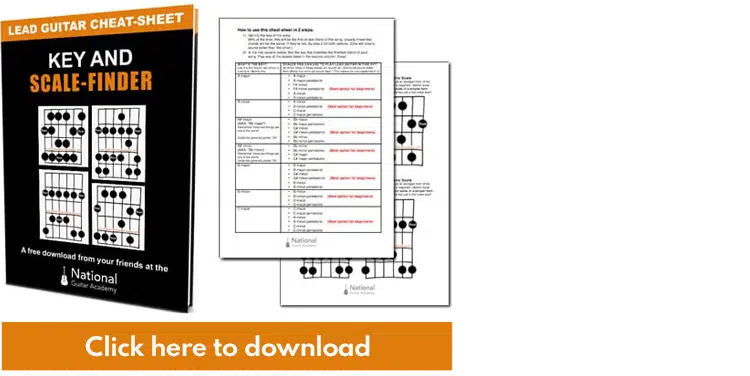
Get your personalised guitar-learning plan 🎸
Get a custom guitar-learning plan here: Click here for GuitarMetrics™
World-Class Guitar Courses 🌎
Learn from the world's best guitar educators: Click here for our guitar courses
Even weirder types of guitar!
This…
… is another type of guitar that has two necks.
The guy playing it is called Michael Angelo from the band Nitro.
He’s famous for playing both necks at once by using a lot of gain on the amp and playing entirely with slurred notes so he doesn’t have to pick.
This…
… is a harp guitar, being sported by acoustic guitar icon Andy McKee.
Those harp strings produce a deep, resonant bass-filled sound.
This…
… is a ten string bass.
There’s a lot of debate amongst the bass playing community as to how these things are actually supposed to be tuned.
These things are also big and heavy with fretboards like shelves, so one to avoid if you’re small and/or a beginner!
What Type of Guitarist Are You?
Take our 60-second quiz & get your results: Take The Quiz
Join the world's best online guitar school 🌎
- Get your own personalised guitar learning plan (customised just for YOU).
- World-class online guitar courses. Learn at your own pace.
- Community Campus & Learning Forum - A friendly community! Connect with our team & students. 😊
- Beginner Song library with chordsheets, tabs and tips. (Songs suitable for all levels!)
- Regular live streams, seminars and Q&A sessions - Learn from world-class guitar educators. Get all your questions answered!
Click here to learn more about National Guitar Academy membership 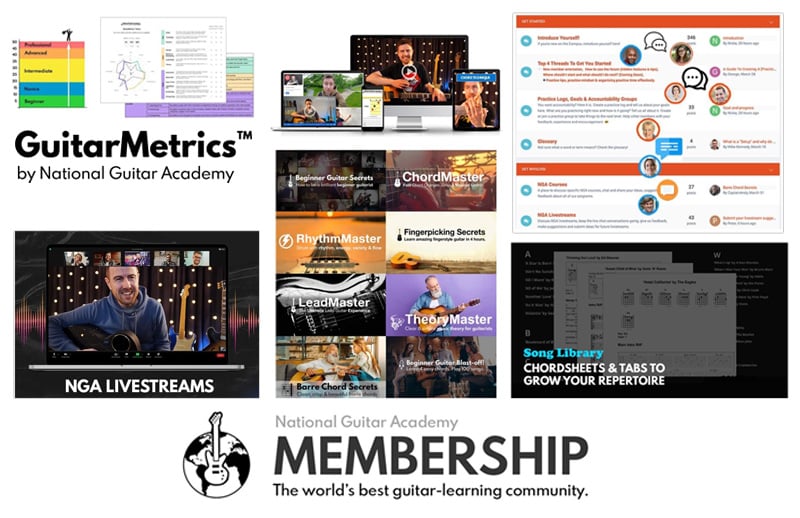
Cool Guitar T-shirts 😎
Look cooler! Check out our merch: Click here to see our merch store
Want free guitar tips and video lessons delivered to your inbox?
Join over 100,000 guitar-learners and subscribe to our guitar-tips-by-email service. (It's free.)
We'll send you a series of lessons that will move you to the next level of your guitar journey.
Learn how everything fits together quickly, easily and effectively. We share ninja tips (for instant fun!) but also timeless fundamentals that will deepen your understanding.


Get our best guitar tips & videos
Popular Lessons
How To Learn Guitar: An 11-Step Programme For Beginners
How To Choose The Perfect Beginner Guitar
More Cool Guitar Stuff
Learn about National Guitar Academy: About Us
Join us on Facebook for daily guitar tips.
Listen to our Learn Guitar Podcast for rapid guitar progress.
Check out our free chord lessons.






